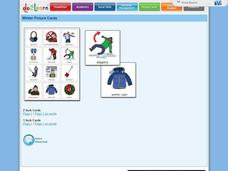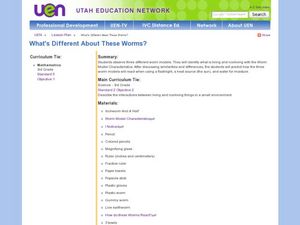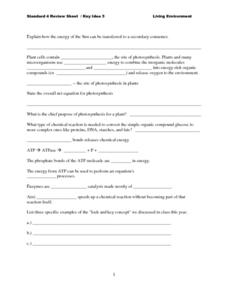Curated OER
Barrels and Buckets: Access to Water - What Would It Be Like to Live in Africa?
Students compare water access in the United States with that of Africa. In this water access lesson, students located Ghana and Kenya on a globe before reading Peace Corps Volunteer accounts of the difficulty of accessing clean water....
Curated OER
How Did Different People Live in Ancient Egyptian Times
What was life like for ancient Egyptians? Well, that depends on a person's job or title. Find out what life was like for pharaohs, priests, scribes, peasants, nobles, and craftsmen in Ancient Egypt. Each slide contains an image and a...
Anglophone School District
Fluids: Force in Fluids
Discuss Archimedes' Principle and fluid forces with your young scientists as they describe the relationship between mass, volume, and density during a series of engaging activities. They use the Participle Theory of Matter to explore the...
Do2Learn
Winter Picture Cards
Find all things winter here! Use the set of winter picture cards to help class members become familiar with the season. The cards include holidays celebrated in winter, to the temperatures we feel in winter.
Concord Consortium
Mixing Liquids
Sometimes being mixed up is a good thing! Young chemists explore the basics of making solutions with a realistic interactive. Pupils observe the differences in volume using quantities of water and ethanol, as well as the effects of...
Concord Consortium
Oil and Water
If you don't get along with someone, it's said that the two of you are like oil and water. Why is this? Explore the phenomenon and explain the phrase in one resource! Science superstars first observe samples of oil and water together....
Curated OER
Do Some Research: 4
In this chemical element research worksheet, students read the sentence and research in the library or on the Internet to find the answer and then write it on the blue line. Students then write a short report about this topic: a chemical...
Curated OER
Moving Out
Students determine their cost of living. In this determining their cost of living lesson, students think of ten necessary things they would need if they moved out of their parents house. Students research the cost of renting an...
Curated OER
Energy in Living Systems
High schoolers are asked: Is our life's purpose over when it's over? What happens to our bodies? They analyze the flow of energy through living systems. Students compare the metabolism of autotrophs with that of heterotrophs. They...
Curated OER
T's Alive! Or Is It?
Learners explore data on the bone, muscle, and skin of living systems and then create a list of characteristics of these systems and relate these characteristics to bone, muscle, and skin.
Curated OER
Life in a Drop of Pond Water
Young scholars investigate living creatures that inhabit a pond and explore how various organisms satisfy their needs within their environments. In this life in a drop of pond water lesson, students examine microorganisms under...
Curated OER
Three Worm Lesson
Third graders observe properties of three worms. In this living and non-living lesson, 3rd graders study characteristics of living and non-living worms. Students experiment to find how light, heat and moisture effects each of the worms....
Curated OER
Interactions Everywhere!
Young scholars examine interactions within the environment and environmental engineering careers. They discuss and view photos of natural and manmade environments, explore various websites, create a web to identify interactions between...
Curated OER
Soil Composition
Students examine soil. In this soil composition lesson students participate in soil sedimentation and filtration activities. The students discuss what non-living and living things are in soil and why it is so important.
Curated OER
Everything Grows
First graders read about the growth of living things. In this similiarities and differences lesson, 1st graders list things that are similiar and different about growing plants. Students then use a graphic organizer to list the...
Curated OER
Health and Growth
Students recognize that living things need food and water. In this health and growth lesson, students identify foods that are better for health and growth. Students sing a song and complete a worksheet. Students understand that they...
Curated OER
Growing plants
Students explore plants and recognize that they are living things that require light and water to grow; students identify, name and match the parts of plants.
Curated OER
Planting Seeds Around the World
First graders discuss the book The Lorax and research what living things need. In this environmental instructional activity, 1st graders investigate how humans affect the growth of plants. Students conduct an experiment with sunflowers.
Curated OER
Standard 4-Photosynthesis, Diseases and the Immune System
In this photosynthesis, disease and Immune System worksheet, students fill in the blanks with key terms to complete sentences about the transfer of energy from the sun to plants, enzymes as catalysts in reactions, homeostasis, the immune...
Curated OER
Gone But Not Forgotten
Third graders examine animals and organisms that have become extinct and their similarities to living organisms. In this extinction lesson plan students divide into groups and research extinct animals.
Curated OER
Flora and Fauna of the Hill Neighborhood
Students compare and contrast the characteristics of plants and animals. In this ecology activity, students observe the outdoors and describe the relationship among different living things. They relate plant diversity with animal diversity.
Curated OER
Living, Non-Living Mobile
Middle schoolers are introduced to the concept of living and nonliving organisms in general and participate in a starter activity where they build their own definitions of living and nonliving organisms.They sort organisms into living...
Curated OER
Looking at the Community Tree
Third graders review the characteristics of living and nonliving organisms. As a class, they observe a tree and describe the interactions between the living and nonliving organisms surrounding it. To end the instructional activity,...
Curated OER
Exploring the Sun's Role in Living Systems
Learners create graphic organizer webs that illustrate their thinking about seasonal physical and biological changes caused by changes in sunlight. They identify the central role of sunlight in living systems.
Other popular searches
- Classify Living Things
- Grouping Living Things
- Basic Needs of Living Things
- Classifying Living Things
- Classification Living Things
- Needs of Living Things
- Non Living Things
- Classifying Living Organisms
- Five Kingdoms of Living Things
- Kingdoms of Living Things
- What Living Things Need
- Living Organisms Biology

























